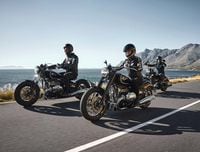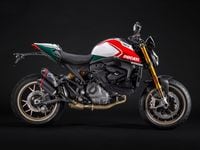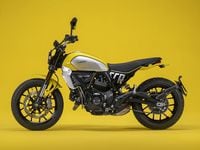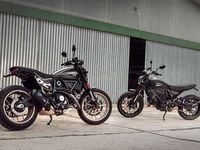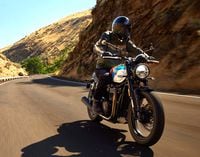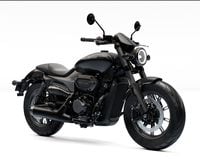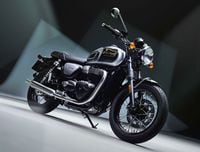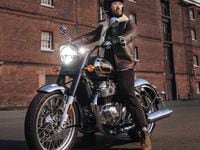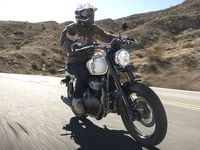This article was originally published in the December 1999 issue of Motorcycle Cruiser.
In a year which has been filled with new attention-grabbing cruisers, Victory’s V92C has clearly been the most significant. Since we choose our Cruiser of the Year based on its impact, the V92C was a shoo-in for the title.
For many American motorcyclists, Victory's first model might be the most momentous motorcycle to arrive in their lifetimes. Victory was the first American company to enter the market with a large-displacement street bike in more than six decades. For almost a half-century, Harley-Davidson was the only American company building big road bikes. Victory ended that era with the V92C.
But Victory’s arrival is more than just a milestone. Because it is part of Polaris, the huge recreational vehicle maker, Victory could call on considerable assets. Polaris has been a tenacious competitor in the other markets it has entered and history has shown that competitors who underestimate the company do so at their own peril.
Having been surprised by Polaris before, the Japanese motorcycle companies have girded themselves for battle. While they seem to have no immediate concern about Victory's arrival in the motorcycle market, they promise a really nasty fight if Victory tries to push them out of their core market. "This isn't snowmobiles or watercraft or even ATVs," said one executive for a Japanese firm, "this is our bread and butter. We have built and nurtured this market. If they plan to come in here and take over, they need to know that it will be war." That sort of talk sounds a bit like the early 1980s, when battles for share devastated the market and prompted H-D to ask for tariff protection from the federal government.
One of the most significant effects to date of the arrival of Victory was the fire it evidently lit under Harley-Davidson. For the first time in 46 years, H-D faced serious home-grown competition. If anyone was in a position to be complacent, it was Harley. It commanded half the cruiser market and would have had more if it could simply build enough bikes to meet the demand. Overtaking Harley in the next decade would be an overwhelming achievement, even if H-D did little to fortify itself. But as we have seen, Harley didn’t sit still. It introduced a new series of engines for its big twins that boast modern technology, greater durability and more power. H-D was probably going to do this eventually, but company execs tell us the impending arrival of Victory provided a catalyst for its efforts. For the 2000-model year, an even more sophisticated version of the new Harley motor takes root in a completely new version of its most popular chassis. We doubt we would have seen those products this soon if Harley hadn’t felt pressure from Victory.
Victory took the high road in its entry into motorcycling and cruising. It didn’t attempt to establish any strained connection to some nearly forgotten American nameplate, or copy key styling themes from Harley. Instead, it built its image around innovative technology and solid performance. The company and the V92C emphasized responsive handling and strong brakes in tandem with traditional cruiser attractions like comfort and broad, accessible power. That power came from a traditional-looking V-twin packing cutting-edge features such as fuel injection and, at least briefly, the most displacement of any cruiser engine designed by the bike’s manufacturer. This propelled the current trend toward bigger and bigger V-twins for cruisers.
As we learned when we took the 35th V92C for a 6000-mile jaunt a year ago, Victory did its homework before it cranked up the assembly lines. The V92C's riding position is among the most comfortable of any cruiser, and the counterbalancer has squelched any propensity to vibrate. The most serious problem we have heard of with any V92C occurred with our own test bike, which broke a belt at the dragstrip after 6000 hard miles. (In retrospect, the belt may have been a victim of the gravel roads the Victory had to contend with during part of our cross-country trek.) Except for one, all other complaints we've heard have been about minor problems, so it appears Victory has produced a solid first effort. With the experience and refinement that production and user feedback produce, future models could be impressive indeed. Our first ride of the company's second model, the V92SC, has us salivating.
Victory’s arrival has stirred up other issues. It claims to have more American content than Harley-Davidson, and offers pricey components like fuel injection and a useful multifunction display in the instrument pod. It also uses a stout 45mm fork design and four-piston brake calipers (which have since turned up on ’00 Harleys). Victory even gives you a toolkit with the bike. Yet at $12,995, it underprices all but the two most affordable H-D big twins. That seems to debunk the theory that Harleys cost so much because they are American-made.
The price also puts the Victory in sharp contrast to Excelsior-Henderson. E-H got to market a few months after Victory, and the two firms are often mentioned in the same breath since they are both entirely new American-made motorcycle brands building cruisers in the same region of the country. (Excelsior builds its bikes in Minnesota. Victory is headquartered in Minneapolis, but builds its engines in Wisconsin and ships them to Iowa for assembly into the bikes.) But the companies have different personalities, in part because Victory is a division of a bigger entity while the Hanlon brothers, the founders of E-H, have run that company.
Excelsior has milked every opportunity for publicity with press releases on all sorts of peripheral issues, while Victory has let its bikes do most of the talking. And with a price that’s $5000 less than the Excelsior-Henderson, Victory speaks a language that more people are likely to understand. There is also the resources issue. With Polaris behind it, Victory can withstand the sort of adversity—a market slowdown, a big recall or other financial woes—that would threaten E-H. However, if a company with Victory’s wherewithal can’t survive, it will be hard for anyone to invest in a new American motorcycle company in the future.
The arrival of Victory as a serious player in the street-bike market is a major development for motorcycling in the States. For the first time in more than 40 years, the American motorcycle industry consists of more than a single formidable motorcycle manufacturer. Beyond the simple historic significance of that fact, the shock waves reverberating through the industry are changing the face of American motorcycling, particularly the cruiser portion. If Victory is successful, it will change the motorcycling scene even more. The introduction of its second model, the V92SC, this summer shows Victory is serious about the motorcycle business.
But that is the future. We are talking about 1999—and what Victory has done in a single year with the V92C makes that motorcycle our uncontested Cruiser of the Year.










/cloudfront-us-east-1.images.arcpublishing.com/octane/6ANTSMUNP6CEJZR76PAU22SH3E.jpg)
/cloudfront-us-east-1.images.arcpublishing.com/octane/H6Z2IC7WYRBXZNQS4MI3SZ5KPQ.jpg)
/cloudfront-us-east-1.images.arcpublishing.com/octane/IWO5T5PBT5E4HFQ5GK47H5YXR4.jpg)
/cloudfront-us-east-1.images.arcpublishing.com/octane/OQVCJOABCFC5NBEF2KIGRCV3XA.jpg)
/cloudfront-us-east-1.images.arcpublishing.com/octane/F3O2DGLA4ZBDJGNVV6T2IUTWK4.jpg)
/cloudfront-us-east-1.images.arcpublishing.com/octane/ZXYQE3MHLFDSPKNGWL7ER5WJ4U.jpg)
/cloudfront-us-east-1.images.arcpublishing.com/octane/RDF24VM7WVCOBPIR3V3R4KS63U.jpg)
/cloudfront-us-east-1.images.arcpublishing.com/octane/W7RSIBFISNHJLIJESSWTEBTZRQ.jpg)
/cloudfront-us-east-1.images.arcpublishing.com/octane/AERA26ENRNBW3K324YWCPEXYKM.jpg)
/cloudfront-us-east-1.images.arcpublishing.com/octane/YWX3YX7QBBHFXFDMEEEKRG4XJE.jpg)
/cloudfront-us-east-1.images.arcpublishing.com/octane/I7OKI53SZNDOBD2QPXV5VW4AR4.jpg)
/cloudfront-us-east-1.images.arcpublishing.com/octane/IH52EK3ZYZEDRD3HI3QAYOQOQY.jpg)
/cloudfront-us-east-1.images.arcpublishing.com/octane/K2FSAN7OWNAXRJBY32DMVINA44.jpg)
/cloudfront-us-east-1.images.arcpublishing.com/octane/G4XK7JL24FCUTKLZWUFVXOSOGE.jpg)
/cloudfront-us-east-1.images.arcpublishing.com/octane/JJNXVAC27ZCDDCMTHTQZTHO55Y.jpg)
